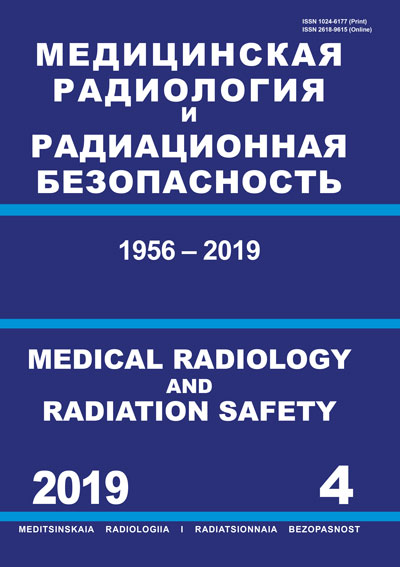Association of Medical Physicists of Russia (President)
Russian Federation
Moscow, Russian Federation
N.N. Blokhin National Medical Research Center of Oncology (Medical Physicist)
CSCSTI 76.03
CSCSTI 76.33
Russian Classification of Professions by Education 14.04.02
Russian Classification of Professions by Education 31.06.2001
Russian Classification of Professions by Education 31.08.08
Russian Classification of Professions by Education 32.08.12
Russian Library and Bibliographic Classification 51
Russian Library and Bibliographic Classification 534
Russian Trade and Bibliographic Classification 5708
Russian Trade and Bibliographic Classification 5712
Russian Trade and Bibliographic Classification 5734
Russian Trade and Bibliographic Classification 6212
Purpose: Modernization and evaluation of the clinical effectiveness of the technology of continuous radiometric monitoring carried out during high-dose chemotherapy of a surgically isolated limb with tumor foci. Material and methods: A modernized radiometric control technology for regional limb perfusion is proposed. It is based on in vivo labeling of erythrocytes with 99mTc eluate followed by continuous monitoring of the activity of labeled erythrocytes as a simulator of a chemotherapy drug over the heart region. Its distinctive features are intravenous injection of a pyrfotech slice after giving inhalation anesthesia to ensure a sufficient level of red blood cell chelation, as well as using 99mTc activity less than its minimum significant level, which allows working with an open source of ionizing radiation without violating the requirements of radiation safety regulations. Results: The developed technology was successfully used with 106 regional perfusion of the upper and lower extremities in patients with melanoma or sarcoma of soft tissues. In 4 cases, according to the results of radiometric control, the intervention of the surgical team was required to reduce the chemical preparation leakage that was occurring. Conclusion: The technology upgraded by us is characterized by ease of implementation, the ability to take timely measures to prevent or reduce the leakage of a chemotherapy drug from an isolated limb according to the results of continuous in vivo radiometric monitoring of 99mTc-labeled red blood cells over the heart, as well as low radiation load on the patient and staff.
high-dose chemotherapy, surgically isolated limb, regional perfusion, chemotherapy leaks, radiometric monitoring
Введение
Среди пациентов, страдающих такими заболеваниями, как меланома кожи, рак кожи и саркомы мягких тканей, выделяют группу с местно-распространенными формами опухолевого процесса. Стандартные методы лечения пораженных конечностей, включающие хирургическое лечение, химио- и лучевую терапию, не всегда оказываются эффективными. Особенности течения болезни иногда не позволяют использовать сохранные оперативные вмешательства, а калечащие операции, например ампутация пораженной конечности, резко снижают качество жизни пациентов. В некоторых случаях тот или иной метод лечения из указанных выше не может быть использован вообще.
1. Clinical recommendations. Cervical cancer. The association of Russian oncologists. 2017. ID: KP537 [cited 2018 Dec 27] Available from: http://cancerlink.ru/cancer/clinical-guidelines-oncology-2017/clinical-guidelines-aor-2017 . (Russian).
2. NCCN (National Comprehensive Cancer Network, OCT 2017) (version 1.2019) Available at nccn.org. [cited 2018 Nov 05]
3. TNM classification of malignant tumours. Sobin LH, Gospodarowicz MK, Wittekind C, eds. 7th ed. NY: Springer-Verlag, 2010. 256 p.
4. Kaprin AD, Titova VA, Kostin AA, Rerberg AG. Improving the Diagnosis and Treatment of Retention Disorders of the Upper Urinary Tract in Patients with Stages IIB-III cancer of the Cervix Uteri. Cancer Urology. 2012;8(2):98-101. DOI:https://doi.org/10.17650/1726-9776-2012-8-2-98-101. (Russian).
5. Rose PG, Ali S, Whitney CW, Lanciano R, Stehman FB. Impact of hydronephrosis on outcome of stage IIIB cervical cancer patients with disease limited to the pelvis, treated with radiation and concurrent chemotherapy: A Gynecologic Oncology Group study. Gynecol. Oncol. 2010; 117(2):270-5. DOI:https://doi.org/10.1016/j.ygyno.2010.01.045.
6. Goklu MR, Seckin KD, Togrul C, Goklu Y, Tahaoglu AE, Oz M, et al. Effect of hydronephrosis on survival in advanced stage cervical cancer. Asian Pac J Cancer Prev. 2015;16(10):4219-22. DOIhttps://doi.org/10.7314/APJCP.2015.16.10.4219
7. Beckta JM, Carter JS, Wan W, Chafe WE, Abayomi OK, Proper MA, et al. Urinary Diversion in the Management of Locally Advanced Cervical Cancer Facilitates the Use of Aggressive Therapy without Adversely Effecting Overall Treatment Time. EC Gynaecology. 2016;3(1): 225-31.
8. Mankad M, Mishra K, Desai A, Patel S. Role of percutaneous nephrostomy in advanced cervical carcinoma with obstructive uropathy: a case series. Indian J Palliat Care. 2009;15(1):37-40.
9. Chepurov AK, Zenkov SS, Mamaev NE, Pronkin EA. Prolonged drainage by ureteral stents: current state of the issue and prospects. Andrology and Genital Surgery. 2009;(2):44-8. (Russian).
10. Pecorelli S. Revised FIGO staging for carcinoma of vulva, cervix, and endometrium. Int J Gynec Obstet. 2009;(105):103-4.
11. Kaprin AD, Titova VA, Kreynina YuM, Kostin AA. Urological complications in oncologic practice: diagnosis, interventional and conservative correction. Moscow; 2011. 168 p. (Russian).
12. Protein-energy deficiency in cancer. In: Baranovsky AYu, editor. Dietetics: Manual 5th edition. St. Petersburg: Piter; 2017. p. 868-74. (Russian).
13. Kurpeshev OK, Mardynsky YuS. Basic principles and methods of radiomodification in radiotherapy. In: Kaprin AD, Mardynsky YuS, editors. Therapeutic Radiology. National leadership. Moscow: GEOTAR-Media; 2018. P. 89-128. (Russian).
14. Brotherhood H, Lange D, Chew BH. Advances in ureteral stents. Transl Androl Urol 2014;3(3):314-9. DOI:https://doi.org/10.3978/j.issn.2223-4683.2014.06.06.
15. Boyko AV, Korytova LI, Oltarzhevskaya ND, editors. Targeted drug delivery in the treatment of cancer patients. Moscow: Special Medical Book Publisher; 2013. p. 200. (Russian).





